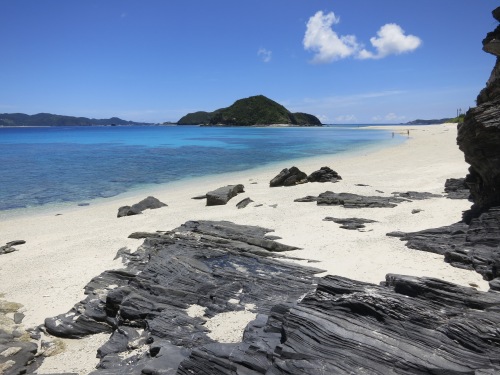Beyond the rustic aesthetic of the temples or serene nature of the shrines, the towering torii gates or the snow-capped mountains, the perfectly manicured gardens or elegantly choreographed tea ceremonies, or the flashy neon mega-cities and ultra-modern transportation methods lies another — and often overlooked — face of Japan: that of the tropical paradise of the Okinawan Islands. Its isolated location in the extreme South of the country, in addition to its sub-tropical climate, creates an atmosphere that seems closer to that of Hawaii than of the everyday Japan that first springs to mind — a fact that many take full advantage of, seeing as it has been a vacation wonderland for many of the neighboring countries. Additionally, its proximity and history of trade with other East Asian countries such as Taiwan, Korea, China, and the Philippines — with some Western influences more recently thrown in — have created a unique culture (and cuisine) that acts as a counter-point to the more traditional Japanese culture that is found in the likes of Tokyo, Kyoto, or Osaka..
Originally a separate kingdom known as the Ryukyu Dynasty, this land of palm-trees, sandy beaches, and unearthly turquoise-blue waters wasn’t officially annexed by Japan until the late 1800’s, making it — in the grand scheme of history — a relatively recent addition. The history of the Ryukyus of the last few hundred years, however, has been anything but blue skies and sunny weather. After a few centuries of “Golden Years” in the 1400 and 1500’s, where the arts and culture were allowed to flourish on the islands, the Ryukyu Dynasty was essentially taken hostage for the next few hundred years by the Shimazu clan to the North (which hailed from what is now Kagoshima). Even after being absorbed into the country of Japan in 1879, the Okinawan Islands suffered some of the most extensive damage and loss of life during World War II. Still to this day, Okinawa has to deal with the difficult-to-ignore presence of a very large American military base on the main island, which has been a lightning rod for controversy for decades now. Regardless of its recent history, however, many of the locals still take fierce pride in their land, they love to welcome and share their culture with visitors from all over the world, and often (to my surprise) identify themselves first and foremost as Okinawans and only secondly as Japanese.
Naha, Japan:
After having spent a week hiking through the mountains and forests along the Kumano Kodo Pilgrimage Trail, I was ready for a change of pace, I was excited to see a different side of modern-day Japan, and I was especially thrilled to finally get the chance to set foot on a proper beach, too! As with most visitors to the area, the fist stop is the bustling city of Naha, the main point of entry on the largest island in the chain (Okinawa-honto). The city itself is a bit kitschy, and although it can quickly become overwhelming after a few days, it is still a great place to learn about the history of the area and to check out the local culinary gems (although that is going to have to wait for another post):

The city’s main street and commercial hub, Kokusai-dori, is awash in neon lights, tourist shops, and beer-logo tank tops
Besides spending all of you time wandering through souvenir stores and wasting away the time sitting in shot bars with the rest of the sunburnt visitors, Naha also offers a few cultural sights for those looking to delve a bit deeper into the area’s history. The main attraction is the Shuri-jo Castle — the seat of power for the Ryukyu Kingdom — which lies perched atop a hillside to the Northeast of the city. My personal favorite, however, was the Fukushu-en, a Chinese-style garden with materials completely imported from mainland China:

I must have picked the wrong time of the day to visit, as any attempt to photograph the Main Hall resulted in a completely washed-out photograph, much like you see above
Zamami-jima, Japan:
To really experience what the Okinawan Islands are like, however, you’ve got to get away from the city and out on a boat — preferably a boat that is heading to an isolated beach somewhere far away from the urban pulse of Naha. Luckily, there are dozens, if not hundreds, of options to choose from, as the entire chain of islands is chock-full of undeveloped stretches of white-sand beaches and hidden coves — perfect places to relax, soak up some sun, and let the sound of the waves be your only connection to the outside world. Although I have plans to head further South to the Yaeyama Islands in a few days, I couldn’t resist taking a ferry ride out to an island called Zamami-jima, which was the ideal balance of pristine, untouched beaches and yet still developed enough that there are places to eat and ways to get around easily (short of hiring a private boat or swimming, that is):
My choice in islands to visit was largely dictated by the presence of a particular beach that I was seeking out — that of Furuzamami Beach. And whereas there is a small, crowded area of the beach that is populated by day-tripper and families, a walk of only a few minutes in either direction yields completely deserted strips of sand and coral that you can claim for you very own (at least for the day!):

The path down to Furuzamami Beach — I always love the wave of anticipation one’s feels upon getting the first peak of a new beach through the trees
Moving forward, I catch another filght even further South to the Yaeyama Islands — specifically Ishigaki and Iriomote Islands — to squeeze in some hiking, hopefully find a kayaking tour, and to take in a slightly more rural view of the Okinawan Island chain. And as usual, I’ve already got the ground work of a Okinawan Food post in the works, so get your appetite ready! Until then, Kampai from Okinawa!

 August 12, 2013
August 12, 2013 




























It looks very similar to Hawaii. 🙂
Sadly, I can’t say that I have been to Hawaii myself, but I only hope that when I do eventually get there, it’ll look like this! 😉
Andrew, these are some of the most awesome photographs you have taken to date! I feel like I am touring with you, great job!!
Thanks, and it wasn’t hard to take great photos here — the place is like one big postcard!
The beaches are beautiful!! 🙂
Yeah, it was pretty easy to fall in love and never want to leave!
That beach! That sea! It really does look like paradise. Great photos!
Thanks!
PARADISE…….. Hi Andrew, thanks for posting this, I’m planning to traveling Japan next year, and after I read this, I put Okinawa to my List 🙂
Thanks, and enjoy your trip!
The color blue here is the most vivid blue I have ever seen! The water is so clear. It must be a grand and beautiful dichotomy between the heat of walking around and the glorious cool of the water.